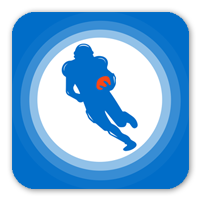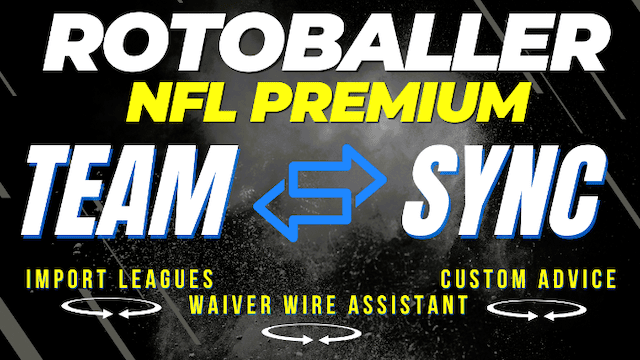Rob investigates the impact of a rookie quarterback on their No. 1 receiver and looks at the rate at which rookie quarterbacks support a top-12 wide receiver in fantasy football.
The 2024 NFL Draft consists of four rookie quarterbacks who are likely selected in the top 10. We could see another 1-2 more quarterbacks selected in the first round. At least nine teams have serious question marks at the quarterback position. It wouldn’t be surprising to see 4-6 rookie quarterbacks start 10 or more games. Instead of focusing on these quarterbacks, we will focus on the impact rookie quarterbacks have had on their No. 1 receiver over the years.
The big question we will focus on is: Can rookie quarterbacks support No. 1 receivers? How often has that happened, and should we downgrade the pass-catchers these rookie quarterbacks will be throwing to? Certainly, much context needs to be considered before coming to a conclusion.
Not every rookie quarterback is created equally. The difference between Andrew Luck and Zach Wilson is enormous, just as between Reggie Wayne and Elijah Moore, who operated as the No. 1 receiver for those respective signal-callers. Let’s see if we can decipher a rookie quarterback's impact on his pass-catchers, specifically his No. 1 receiver. If you want to take advantage of our great premium tools, please use promo code "BOOM" to receive a 10% discount.
Featured Promo: New Novig users get a $25 purchase match (50% discount up to $25) on your first Novig deposit, and 3 free months of RotoBaller's "Big-4" Premium Pass (NFL, NBA, MLB, NHL) which includes exclusive tools for Betting, Props, DFS and more! CLAIM IT NOW
The Metrics
We’ll begin with our sample. From 2005-2021, 39 first- or second-round quarterbacks started at least 10 games in their rookie seasons. 36 of these were first-rounders. 28 were selected in the top 10, and 24 were selected in the top five. We’ll use these rookie quarterbacks to help us determine the impact of rookie quarterbacks on their No. 1 receivers.
Every year, what constitutes a WR1 season is different. In 2016, the WR12 finished with a 12.1 half-PPR PPG average. In 2007, the WR12 finished with a 14.5 half-PPR PPG average. The average of every WR12 from our 17-year sample equaled 13.4 half-PPR PPG. The mode and the median equaled 13.3 half-PPR PPG.
Only six rookie quarterbacks out of our 39 group sample supported a fantasy receiver who scored 13.3 half-PPR PPG, our WR1 baseline. That equates to just 15%. The average draft slot of those six quarterbacks was 1.058. It included two No. 1 overall picks. Four of the six receivers who achieved this feat were selected in the first round of the NFL Draft and two in the third round. Three of them have strong resumes for a Hall of Fame induction. Two of them have resumes that are befitting of a spot in the Hall of Really, Really Good if it were such a thing.
The half-PPR PPG average for WR24 from 2005-2021 was 11.1, and the median was 11.2. We had another seven rookie quarterbacks who supported receivers who finished between 11.1 and 13.2 half-PPR PPG, our WR13-WR24 range.
The seven rookie quarterbacks who helped achieve this were drafted, on average, at the 1.16. However, that is being affected strongly by Andy Dalton and his 2.03 draft slot. The average of the other six is 1.02. It includes one Hall of Fame receiver, another future Hall of Famer, and two guys who would make the Hall of Really Good. It includes three former first-round receivers and three former second-round receivers.
The final half-PPR PPG for all 39 No. 1 receivers in our rookie quarterback sample was 10.4. The average draft slot for all 39 quarterbacks was 1.13. Of our 39 No. 1 receivers in this study, 15 had at least one season with a half-PPR PPG average of 13.3 or higher, and 10 had two or more such seasons.
Rookie Quarterbacks Who Supported WR1s
First, let's discuss our six quarterback-receiver combinations who accomplished the feat. Keenan Allen averaged 14.6 half-PPR PPG with rookie Justin Herbert in 2020. Herbert averaged 39.7 passes per game, which was the fourth highest that season. Allen surpassed 13.3 half-PPR PPG back in 2017 and again in 2023. He had three other seasons scoring between 12.5 and 13.0 half-PPR PPG, so he’s no slouch. We may be talking about Allen in the Hall of Fame by the time his career is done if he can stay healthy and produce for another 2-3 seasons.
The second combination was DeAndre Hopkins and Deshaun Watson in 2017. Watson ended up tearing his ACL in Week 8. From Weeks 1-8, Hopkins averaged 17.9 half-PPR PPG. His stretch with Watson was the highest half-PPR PPG mark of his career. Watson had finished with a PPG average higher than 13.3 in 2015, 2017, 2018, 2019, and 2020. He finished with a PPG average higher than 12.0 in 2014 and 2021. When he becomes eligible, Hopkins will almost certainly be in the Hall of Fame.
Andrew Luck and Reggie Wayne were our third qualifiers back in 2012. Wayne averaged 13.6 half-PPR PPG with Luck under center in his first season. Wayne had WR1 qualifying seasons in 2004, 2006, 2007, 2009, and 2010. In 2012, Wayne finished the final season with a PPG average higher than 11.7. Luck was widely viewed as a true generational quarterback prospect, and Wayne will likely become a Hall of Famer.
Our fourth duo is going to catch people by surprise. Christian Ponder started 10 games as a rookie in 2011. During that time, Percy Harvin averaged 16.8 half-PPR PPG. 14.96 half-PPR PPG came from his receiving stats. Harvin’s career was cut short and limited due to injuries, but this was the only season in which Harvin surpassed our 13.3 half-PPR PPG threshold.
Our final two combinations included Cam Newton and Steve Smith Sr. in 2011 and Matt Ryan and Roddy White in 2008. Smith averaged 13.8 half-PPR PPG, while White averaged 14.0 half-PPR PPG. Smith surpassed that number in 2005, 2006, and 2008. 2011 was his final season with a 13.3 half-PPR PPG average. White eclipsed that 13.3 half-PPR PPG mark in 2009, 2010, 2011, and again in 2012. 2008 was his first season with a 13.3 half-PPR PPG or higher.
Rookie Quarterbacks Who Supported WR2s
We had seven quarterbacks who supported No. 1 receivers who finished with an 11.1-13.2 half-PPR PPG average, our WR13-24 range. This group included Matt Leinart and Anquan Boldin in 2006. Boldin surpassed our WR1 PPG average of 13.3 in 2005, 2007, and 2008. Boldin had 152 targets, 83 receptions, and 1,203 yards in 2006 but had just four touchdowns.
Calvin Johnson had an 11.5 half-PPR PPG average with rookie Matthew Stafford in 2009. Johnson had the lowest catch percentage of his career and just five touchdowns on 137 targets. He surpassed our 13.3 WR1 threshold in 2008 and 2010-2015. Andy Dalton was a second-rounder in 2011 but became the Bengals starter. He helped rookie A.J. Green finish with a 12.0 half-PPR PPG average. Green finished as a WR1 in 2012, 2013, and 2015.
In 2015, rookie Jameis Winston helped Mike Evans to an 11.7 half-PPR PPG average in his rookie season. Much like Boldin, Evans fell victim to some bad touchdown luck. Evans had 12 touchdowns in 2014 and 2016. In 2015, Evans had just three touchdowns on 148 targets. He surpassed our WR1 threshold line in 2014, 2016, 2018-2021, and 2023.
Delanie Walker, a tight end, surpassed our WR2 threshold in 2015 with rookie Marcus Mariota. This was the best season of his career, and he finished as the TE3. Our final two rookie quarterbacks who supported WR2 receivers were Daniel Jones and Joe Burrow in 2019 and 2020, respectively. Golden Tate averaged 11.6 and Tyler Boyd averaged 12.8 half-PPR PPG. None of these three players ever went on to have a season with a 13.3 half-PPR PPG average.
What’s wild is that Boldin, Johnson, and Evans combined for 458 targets in their three seasons with rookie quarterbacks but had just 12 touchdowns together. That’s a 2.6% touchdown rate. To put that into perspective, Desmond Ridder has a 2.8% touchdown rate for his career. Mac Jones is at 3.5%. Zach Wilson is at 2.3%. Leinart had a 2.9% touchdown rate in his rookie season. Stafford was at 3.4% and Winston was at 4.1%.
For their careers, Boldin had a 4.7% touchdown rate, Johnson had a 6.3% touchdown rate, and Evans is currently at 7.1%. That’s just bad luck to some extent. We would expect rookie quarterbacks to throw fewer touchdowns, but not to the extent that we saw with Boldin, Johnson, and Evans.
Examining the 26 Failures
At this point, it would be easy to conclude that rookie quarterbacks cannot support WR1s at a high rate. The math has proven that to be true. However, context is always important. Can we expect a rookie quarterback to make a receiver score 13.3 half-PPR PPG if that receiver never did that in his entire career? Is that the quarterback’s fault or the receiver’s? We will break up our remaining 26 receivers into two groups. We’ll start with 14 receivers from 2005-2014.
Rookie Quarterbacks and Their No. 1 Receiver From 2005-2014
| Year | QB | Pick | WR |
| 2005 | Alex Smith | 1.01 | Brandon Lloyd |
| 2006 | Vince Young | 1.03 | Drew Bennett |
| 2008 | Joe Flacco | 1.18 | Derrick Mason |
| 2009 | Mark Sanchez | 1.05 | Jerricho Cotchery |
| 2009 | Josh Freeman | 1.17 | Kellen Winslow |
| 2010 | Sam Bradford | 1.01 | Danny Amendola |
| 2011 | Blaine Gabbert | 1.1 | Mike Thomas |
| 2012 | Robert Griffin III | 1.02 | Pierre Garcon |
| 2012 | Ryan Tannehill | 1.08 | Brian Hartline |
| 2013 | EJ Manuel | 1.16 | Stevie Johnson |
| 2013 | Geno Smith | 2.07 | Jeremy Kerley |
| 2014 | Blake Bortles | 1.03 | Allen Hurns |
| 2014 | Teddy Bridgewater | 1.32 | Greg Jennings |
| 2014 | Derek Carr | 2.04 | James Jones |
In this sample, we have 14 rookie quarterbacks and their No. 1 receivers, which you can see from the table above. The average half-PPR PPG from these 14 receivers was just 8.5. Five of these 14 receivers had at least one season with a 13.3 half-PPR PPG average or higher.
However, we need to take this with a massive grain of salt. Below you will find a scatter graph of these 14 receivers. You'll find their half-PPR PPG average with their rookie quarterback in blue. The red dot represents their five-year half-PPR PPG average, including the season with their rookie quarterback and two years before and after. In yellow, you'll see their career's highest half-PPR PPG average.
We need to go over some things when looking at the graph above. Let's start with our five receivers with a WR1 qualifying season on their career resume but failed to reach that height with a rookie quarterback. First up is Brandon Lloyd. In 2005, he averaged 7.9 half-PPR PPG with rookie Alex Smith. He went on to have one WR1 type of season in 2010. It was his only season with 1,000 or more yards. Looking at Lloyd’s career, 2010 was an outlier and came five years after Smith's rookie season. As you can see above, his half-PPR PPG average with Alex Smith was higher than his five-year half-PPR PPG window.
Next up is Drew Bennett in 2006. The graph above shows that his half-PPR PPG average with his rookie quarterback was similar to his five-year window average. However, like Lloyd, Bennett also has a WR1 qualifying season. This occurred in 2004 and thus included in that five-year window average. However, this was Bennett's only season with more than 800 yards.
In 2008, rookie Joe Flacco's No. 1 receiver was Derrick Mason, who averaged a respectable 10.8 half-PPR PPG average, higher than Mason's five-year window PPG average. However, Mason did have just one season with a half-PPR PPG average higher than 13.3. That season came five years before Flacco was drafted, back in 2003.
Our fourth and final outlier was in 2014, with rookie Teddy Bridgewater and veteran Greg Jennings. Jennings had four WR1 qualifying seasons, the most recent being in 2011. He retired after the 2015 season, meaning his 2014 season with Bridgewater was closer to his retirement than his last WR1 season. His half-PPR PPG average with Bridgewater ended up being higher than his four-year window since he only had one season post-2014. It would be ill-advised to hold these rookie quarterbacks responsible for these receivers not reaching a WR1 qualifying season.
One other receiver failed to finish as a WR1 with a rookie quarterback but had a WR1 season. That player was Pierre Garcon, who crossed our 13.3 half-PPR PPG threshold the next season. However, Garcon's 10.9 half-PPR PPG average with Robert Griffin III in 2012 was higher than his five-year window PPG average. None of the nine remaining receivers in this sample had a WR1 qualifying season on their resume. There were nine receivers whose half-PPR PPG average was higher in the season with their respective rookie quarterback than their five-year window.
Zero of these 14 receivers averaged more than 11.1 half-PPR PPG with their rookie quarterbacks, our WR2 threshold. We've discussed the five receivers in this sample who surpassed our WR1 threshold, but four others exceeded our WR2 threshold of 11.1 half-PPR PPG. That means five other receivers never had a WR2-caliber season. Interestingly enough, 10 of our 14 receivers in this sample had a higher half-PPR PPG average than they did in their five-year window PPG average. Only two of these 14 receivers had a five-year window PPG average greater than 10.
The rookie quarterbacks in this sample were expected to produce with No. 1 receivers Jerricho Cotchery, Danny Amendola, Mike Thomas, Brian Hartline, Jeremy Kerley, Allen Hurns, 31-year-old Greg Jennings, or 30-year-old James Jones. Is it fair to say these rookie quarterbacks could not support a No. 1 receiver? Let’s dissect our second sample from our most recent time frame.
Rookie Quarterbacks and Their No. 1 Receiver From 2015-2021
Our second sample consists of 12 receivers from 2015-2021. One glance at who these rookie quarterbacks had as their No. 1 receivers will make your head spin. How could any franchise throw their rookie quarterback to the wolves like that?
However, that's exactly what so many of these franchises did. The amount of support these rookie signal-callers received in their rookie season can only be defined as organizational malpractice. Trubisky, Darnold, Allen, Tagovailoa, Lawrence, Wilson, Fields, and Jones were all, for a lack of a better word, screwed. It is that simple.
| Year | QB | Pick | WR |
| 2016 | Jared Goff | 1.01 | Kenny Britt |
| 2016 | Carson Wentz | 1.02 | Zach Ertz |
| 2017 | Mitch Trubisky | 1.01 | Kendall Wright |
| 2018 | Baker Mayfield | 1.01 | Jarvis Landry |
| 2018 | Sam Darnold | 1.03 | Robbie Chosen |
| 2018 | Josh Allen | 1.07 | Zay Jones |
| 2019 | Kyler Murray | 1.01 | Christian Kirk |
| 2020 | Tua Tagovailoa | 1.05 | DeVante Parker |
| 2021 | Trevor Lawrence | 1.01 | Marvin Jones |
| 2021 | Zach Wilson | 1.02 | Elijah Moore |
| 2021 | Justin Fields | 1.11 | Darnell Mooney |
| 2021 | Mac Jones | 1.15 | Jakobi Meyers |
Below is another scatter plot graph for this sample of 12 receivers. You'll find their half-PPR PPG average with their rookie quarterback in blue. The red dot represents their five-year half-PPR PPG average, including the season with their rookie quarterback and two years before and after.
In yellow, you'll see their career's highest half-PPR PPG average. Eight of these 12 receivers had a higher half-PPR PPG average with their respective rookie quarterbacks than their five-year window PPG average. Two of our 12 receivers in this sample had a five-year window average greater than 10 half-PPR PPG.
In our previous sample, we had five receivers who had surpassed a 13.3 half-PPR PPG average once in their career. There was just one in this group. That one player was tight end Zach Ertz. How much responsibility do these rookie quarterbacks have to carry when your No. 1 receiver is Kendall Wright in his final season in the NFL or Zay Jones or 31-year-old Marvin Jones Jr. or Elijah Moore or Darnell Mooney?
Ertz is the only player in this sample to have one season with a high-PPR PPG average higher than our WR1 threshold of 13.3. That happened in 2018, but rookie Carson Wentz still helped Ertz finish as the TE6 in his rookie season under center. Of the 11 other No. 1 receivers, just four of them ever exceeded our WR2 threshold of 11.1 half-PPR PPG. Those four included Jarvis Landry, Christian Kirk, DeVante Parker, and Marvin Jones.
Kirk was paired up with rookie Kyler Murray in 2019. He first reached his first WR2 qualifying season in 2022. This was three years later and has been his only WR2 qualifying season of his career. In 2020, Tua Tagovailoa was paired up with No. 1 receiver DeVante Parker.
The year before, Parker flirted with a WR1-caliber season with Ryan Fitzpatrick under center. He averaged 13.1 half-PPR PPG in that season. He had 1,202 yards. In his nine-year career, he has just two seasons with more than 750 yards. His 2019 season was the only WR2 qualifying season of his nine-year career and a clear outlier in an otherwise disappointing career.
Jones has been in the NFL for 11 seasons and had just one season with 1,000 yards. He has never had a WR1-caliber season and just two WR2-caliber seasons. In his 2021 season with rookie Trevor Lawrence, he was 31 years old. Landry is the only one of this quartet who routinely performed at a WR2 level.
Conclusion
Twenty-two receivers in our 39-receiver sample have no history of a WR1-caliber season. Looking at their highest half-PPR PPG averages in their careers, they come out to an average of just 10.7. Think about that. Taking the best season of 22 of our 39 receivers, the average of this sample doesn’t even cross our WR2 threshold number of 11.1 half-PPR PPG. That is over 56% of our sample.
Sixteen receivers had at least one WR1 qualifying season in their career. Six of them posted WR1 seasons with their rookie quarterback. Of those six, Harvin was the only receiver who only posted a WR1-caliber season with their rookie quarterback and had no other WR1-caliber season. The other five all posted multiple seasons with WR1 qualifying seasons.
Four of the remaining 16 posted WR2 qualifying seasons with their rookie quarterbacks. The remaining six receivers who failed to achieve a WR2-caliber season were Brandon Lloyd, Drew Bennett, Derrick Mason, Greg Jennings, Pierre Garcon, and tight end Zach Ertz. As previously mentioned, Lloyd and Bennett’s WR1 seasons were complete outliers in their career. Mason and Garcon just missed the WR2 cut-off by 0.3 and 0.3 PPG, respectively. Jennings' last WR1 season was three years prior.
Unfortunately, the conclusion is not groundbreaking; it likely isn't all that much of a surprise at this point. We cannot conclusively say that rookie quarterbacks cannot support WR1s. So often in our 17-year sample, these rookie quarterbacks were not provided with a WR1-caliber receiver.
There are still many rookie quarterbacks that weren't even provided a WR2-caliber receiver. Is it fair then to conclude rookie quarterbacks cannot support high-end fantasy receivers when so many of these receivers never posted such a season in their entire careers?
The conclusion to this case study is simple. Trust the talent of the receiver. It sounds easy, but there's little data to indicate it was the rookie quarterback's fault for the lack of receiver production in many cases. There is some risk of a lower ceiling with a rookie quarterback, but that does not necessarily mean a WR1 season isn't in the cards, as long as the receiver's talent aligns with that possible outcome. Trust the talent.
Looking forward to 2024, what does that mean for some of our receivers likely catching passes from rookie quarterbacks? D.J. Moore was a top-10 receiver last year with Justin Fields. If, or rather when, they draft Caleb Williams, your outlook for Moore should not change.
Terry McLaurin also seems to be catching passes from a rookie. McLaurin has never posted a WR1-caliber season before, so that shouldn't be the expectation. However, there is untapped upside with a rookie since McLaurin has never had above-average quarterback play. Fantasy managers shouldn't be fading McLaurin; they should be intrigued.
As for the New England pass-catchers, if the Patriots choose to take a quarterback at No. 3 overall in this year's NFL Draft, these pass-catchers should be avoided not because of their rookie quarterback but because their pass-catchers are likely to be awful. They certainly are at this point, so unless major changes occur this offseason, fantasy managers should ignore these pass-catchers because they've historically been bad not because of their rookie quarterback.
As a reminder, please use promo code "BOOM" at checkout for 10% off any premium purchase.
Download Our Free News & Alerts Mobile App
Like what you see? Download our updated fantasy football app for iPhone and Android with 24x7 player news, injury alerts, rankings, starts/sits & more. All free!






 RADIO
RADIO


























